Block Chain Technology and Its Impacts
VerifiedAdded on 2023/05/31
|8
|2095
|194
AI Summary
This essay discusses the technology of block chain and its impacts. It defines block chain technology, its advantages, and social implications. The essay also talks about the success of block chain technology in the form of Bit coin.
Contribute Materials
Your contribution can guide someone’s learning journey. Share your
documents today.
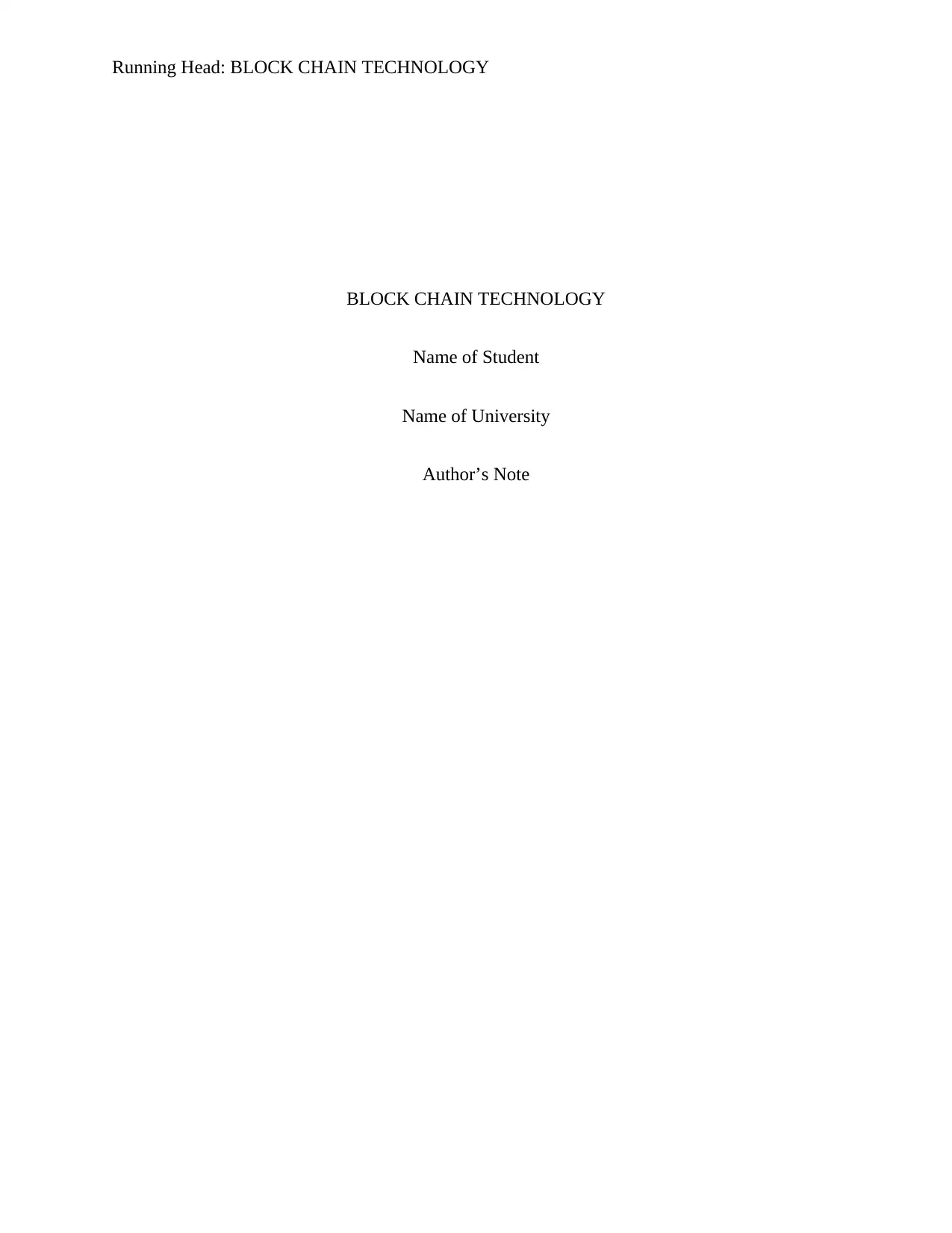
Running Head: BLOCK CHAIN TECHNOLOGY
BLOCK CHAIN TECHNOLOGY
Name of Student
Name of University
Author’s Note
BLOCK CHAIN TECHNOLOGY
Name of Student
Name of University
Author’s Note
Secure Best Marks with AI Grader
Need help grading? Try our AI Grader for instant feedback on your assignments.

1BLOCK CHAIN TECHNOLOGY
Introduction
Block chain technology can be defined as a process where one internet user is able to
transfer a part of digital property to another internet user. The safety and security of this transfer
is guaranteed (Cohen, Samuelson & Katz, 2017). Everyone would know regarding the transfer
but no one can affect the legitimacy of that the transfer that has been carried out. With the help of
a block chain, people are allowed to write entries in the form of a record and then a particular
community of few users would control hoe that information is updated and amended. This essay
discusses regarding the technology of block chain and its impacts.
Discussion
Block chain could be defined as a digital ledger of numerous financial transactions. The
ledger is incorruptible in nature. These economic transactions can be programmed in order to
record various financial transactions as well as anything that contains value (Yli-Huumo, Choi &
Park, 2016) The data contained in a block chain can be considered as a reconciled and shared
database. This is a process where network is used and benefits can be obtained for obvious.
“Block chain is a vast, global distributed ledger or database running on millions of devices and
open to anyone, where not just information but anything of value — money, but also titles,
deeds, identities, even votes — can be moved, stored and managed securely and privately. Trust
is established through mass collaboration and clever code rather than by powerful intermediaries
like governments and banks.” (Underwood, 2016). The database of a block chain cannot be
stored in a particular location. This means that the data that are recorded in block chain can be
verified very easily and are public (Pilkington & Lee, 2017). This data is not available in any
centralized version where any unauthorized user can edit it or misuse it. The main advantage of
Introduction
Block chain technology can be defined as a process where one internet user is able to
transfer a part of digital property to another internet user. The safety and security of this transfer
is guaranteed (Cohen, Samuelson & Katz, 2017). Everyone would know regarding the transfer
but no one can affect the legitimacy of that the transfer that has been carried out. With the help of
a block chain, people are allowed to write entries in the form of a record and then a particular
community of few users would control hoe that information is updated and amended. This essay
discusses regarding the technology of block chain and its impacts.
Discussion
Block chain could be defined as a digital ledger of numerous financial transactions. The
ledger is incorruptible in nature. These economic transactions can be programmed in order to
record various financial transactions as well as anything that contains value (Yli-Huumo, Choi &
Park, 2016) The data contained in a block chain can be considered as a reconciled and shared
database. This is a process where network is used and benefits can be obtained for obvious.
“Block chain is a vast, global distributed ledger or database running on millions of devices and
open to anyone, where not just information but anything of value — money, but also titles,
deeds, identities, even votes — can be moved, stored and managed securely and privately. Trust
is established through mass collaboration and clever code rather than by powerful intermediaries
like governments and banks.” (Underwood, 2016). The database of a block chain cannot be
stored in a particular location. This means that the data that are recorded in block chain can be
verified very easily and are public (Pilkington & Lee, 2017). This data is not available in any
centralized version where any unauthorized user can edit it or misuse it. The main advantage of
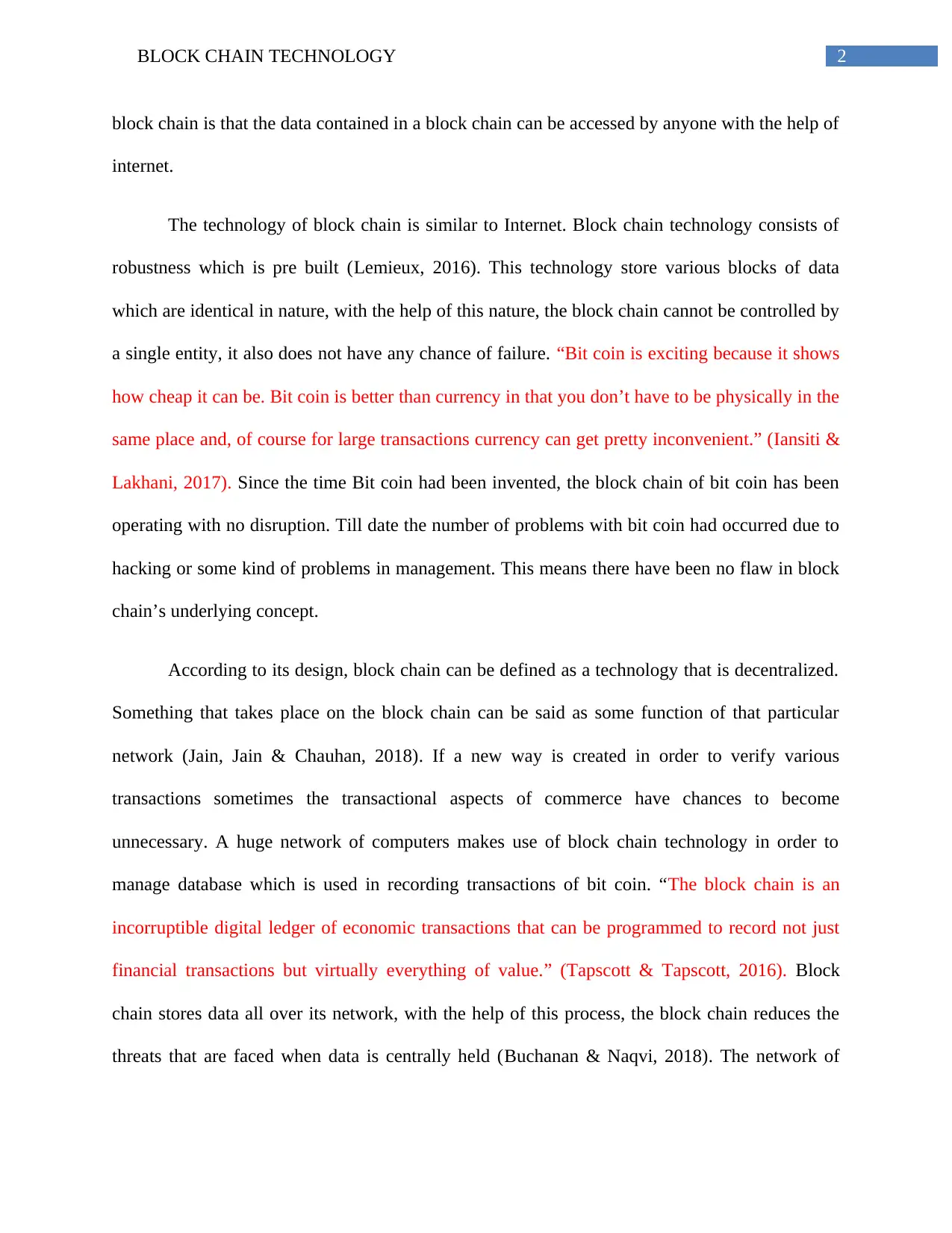
2BLOCK CHAIN TECHNOLOGY
block chain is that the data contained in a block chain can be accessed by anyone with the help of
internet.
The technology of block chain is similar to Internet. Block chain technology consists of
robustness which is pre built (Lemieux, 2016). This technology store various blocks of data
which are identical in nature, with the help of this nature, the block chain cannot be controlled by
a single entity, it also does not have any chance of failure. “Bit coin is exciting because it shows
how cheap it can be. Bit coin is better than currency in that you don’t have to be physically in the
same place and, of course for large transactions currency can get pretty inconvenient.” (Iansiti &
Lakhani, 2017). Since the time Bit coin had been invented, the block chain of bit coin has been
operating with no disruption. Till date the number of problems with bit coin had occurred due to
hacking or some kind of problems in management. This means there have been no flaw in block
chain’s underlying concept.
According to its design, block chain can be defined as a technology that is decentralized.
Something that takes place on the block chain can be said as some function of that particular
network (Jain, Jain & Chauhan, 2018). If a new way is created in order to verify various
transactions sometimes the transactional aspects of commerce have chances to become
unnecessary. A huge network of computers makes use of block chain technology in order to
manage database which is used in recording transactions of bit coin. “The block chain is an
incorruptible digital ledger of economic transactions that can be programmed to record not just
financial transactions but virtually everything of value.” (Tapscott & Tapscott, 2016). Block
chain stores data all over its network, with the help of this process, the block chain reduces the
threats that are faced when data is centrally held (Buchanan & Naqvi, 2018). The network of
block chain is that the data contained in a block chain can be accessed by anyone with the help of
internet.
The technology of block chain is similar to Internet. Block chain technology consists of
robustness which is pre built (Lemieux, 2016). This technology store various blocks of data
which are identical in nature, with the help of this nature, the block chain cannot be controlled by
a single entity, it also does not have any chance of failure. “Bit coin is exciting because it shows
how cheap it can be. Bit coin is better than currency in that you don’t have to be physically in the
same place and, of course for large transactions currency can get pretty inconvenient.” (Iansiti &
Lakhani, 2017). Since the time Bit coin had been invented, the block chain of bit coin has been
operating with no disruption. Till date the number of problems with bit coin had occurred due to
hacking or some kind of problems in management. This means there have been no flaw in block
chain’s underlying concept.
According to its design, block chain can be defined as a technology that is decentralized.
Something that takes place on the block chain can be said as some function of that particular
network (Jain, Jain & Chauhan, 2018). If a new way is created in order to verify various
transactions sometimes the transactional aspects of commerce have chances to become
unnecessary. A huge network of computers makes use of block chain technology in order to
manage database which is used in recording transactions of bit coin. “The block chain is an
incorruptible digital ledger of economic transactions that can be programmed to record not just
financial transactions but virtually everything of value.” (Tapscott & Tapscott, 2016). Block
chain stores data all over its network, with the help of this process, the block chain reduces the
threats that are faced when data is centrally held (Buchanan & Naqvi, 2018). The network of
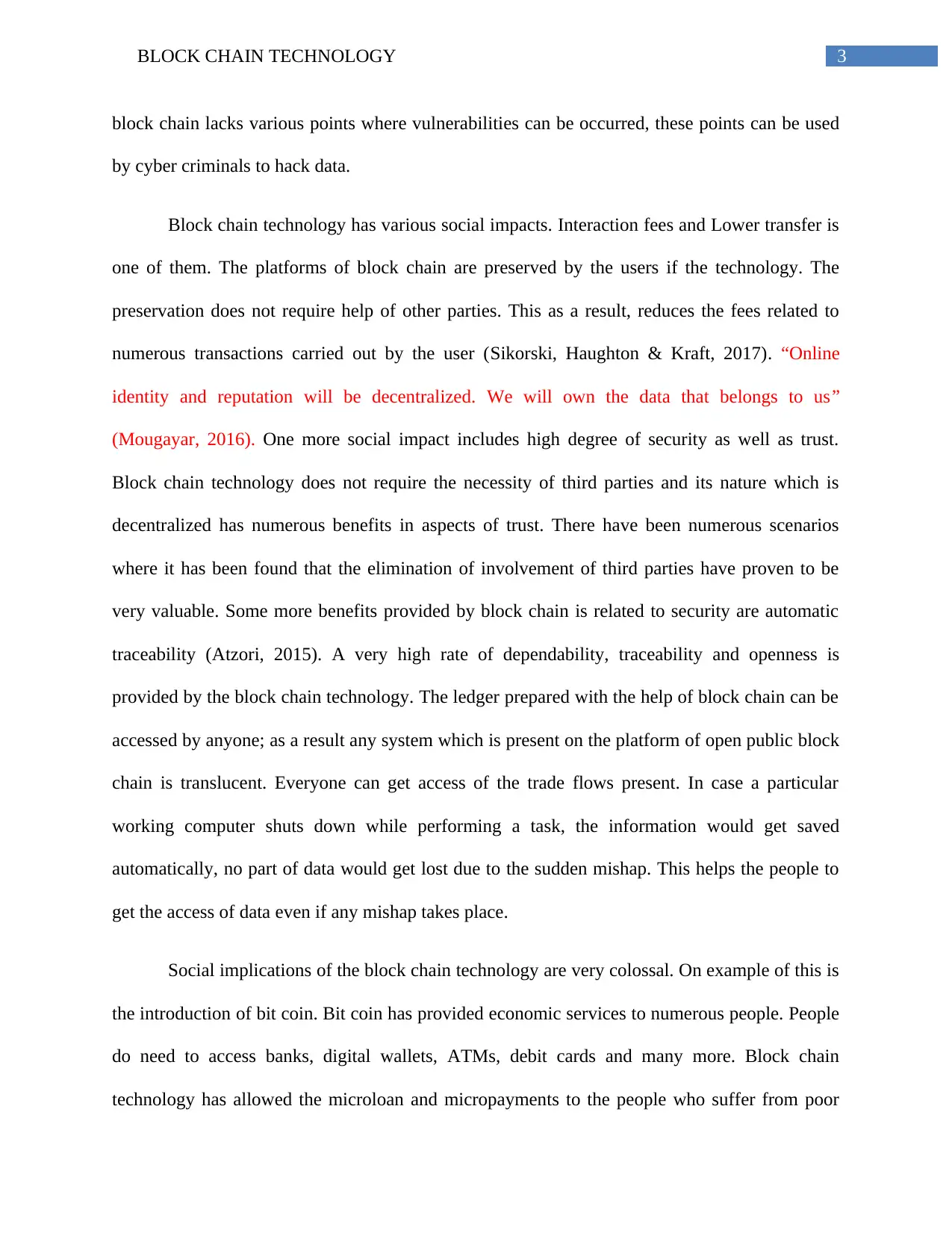
3BLOCK CHAIN TECHNOLOGY
block chain lacks various points where vulnerabilities can be occurred, these points can be used
by cyber criminals to hack data.
Block chain technology has various social impacts. Interaction fees and Lower transfer is
one of them. The platforms of block chain are preserved by the users if the technology. The
preservation does not require help of other parties. This as a result, reduces the fees related to
numerous transactions carried out by the user (Sikorski, Haughton & Kraft, 2017). “Online
identity and reputation will be decentralized. We will own the data that belongs to us”
(Mougayar, 2016). One more social impact includes high degree of security as well as trust.
Block chain technology does not require the necessity of third parties and its nature which is
decentralized has numerous benefits in aspects of trust. There have been numerous scenarios
where it has been found that the elimination of involvement of third parties have proven to be
very valuable. Some more benefits provided by block chain is related to security are automatic
traceability (Atzori, 2015). A very high rate of dependability, traceability and openness is
provided by the block chain technology. The ledger prepared with the help of block chain can be
accessed by anyone; as a result any system which is present on the platform of open public block
chain is translucent. Everyone can get access of the trade flows present. In case a particular
working computer shuts down while performing a task, the information would get saved
automatically, no part of data would get lost due to the sudden mishap. This helps the people to
get the access of data even if any mishap takes place.
Social implications of the block chain technology are very colossal. On example of this is
the introduction of bit coin. Bit coin has provided economic services to numerous people. People
do need to access banks, digital wallets, ATMs, debit cards and many more. Block chain
technology has allowed the microloan and micropayments to the people who suffer from poor
block chain lacks various points where vulnerabilities can be occurred, these points can be used
by cyber criminals to hack data.
Block chain technology has various social impacts. Interaction fees and Lower transfer is
one of them. The platforms of block chain are preserved by the users if the technology. The
preservation does not require help of other parties. This as a result, reduces the fees related to
numerous transactions carried out by the user (Sikorski, Haughton & Kraft, 2017). “Online
identity and reputation will be decentralized. We will own the data that belongs to us”
(Mougayar, 2016). One more social impact includes high degree of security as well as trust.
Block chain technology does not require the necessity of third parties and its nature which is
decentralized has numerous benefits in aspects of trust. There have been numerous scenarios
where it has been found that the elimination of involvement of third parties have proven to be
very valuable. Some more benefits provided by block chain is related to security are automatic
traceability (Atzori, 2015). A very high rate of dependability, traceability and openness is
provided by the block chain technology. The ledger prepared with the help of block chain can be
accessed by anyone; as a result any system which is present on the platform of open public block
chain is translucent. Everyone can get access of the trade flows present. In case a particular
working computer shuts down while performing a task, the information would get saved
automatically, no part of data would get lost due to the sudden mishap. This helps the people to
get the access of data even if any mishap takes place.
Social implications of the block chain technology are very colossal. On example of this is
the introduction of bit coin. Bit coin has provided economic services to numerous people. People
do need to access banks, digital wallets, ATMs, debit cards and many more. Block chain
technology has allowed the microloan and micropayments to the people who suffer from poor
Secure Best Marks with AI Grader
Need help grading? Try our AI Grader for instant feedback on your assignments.
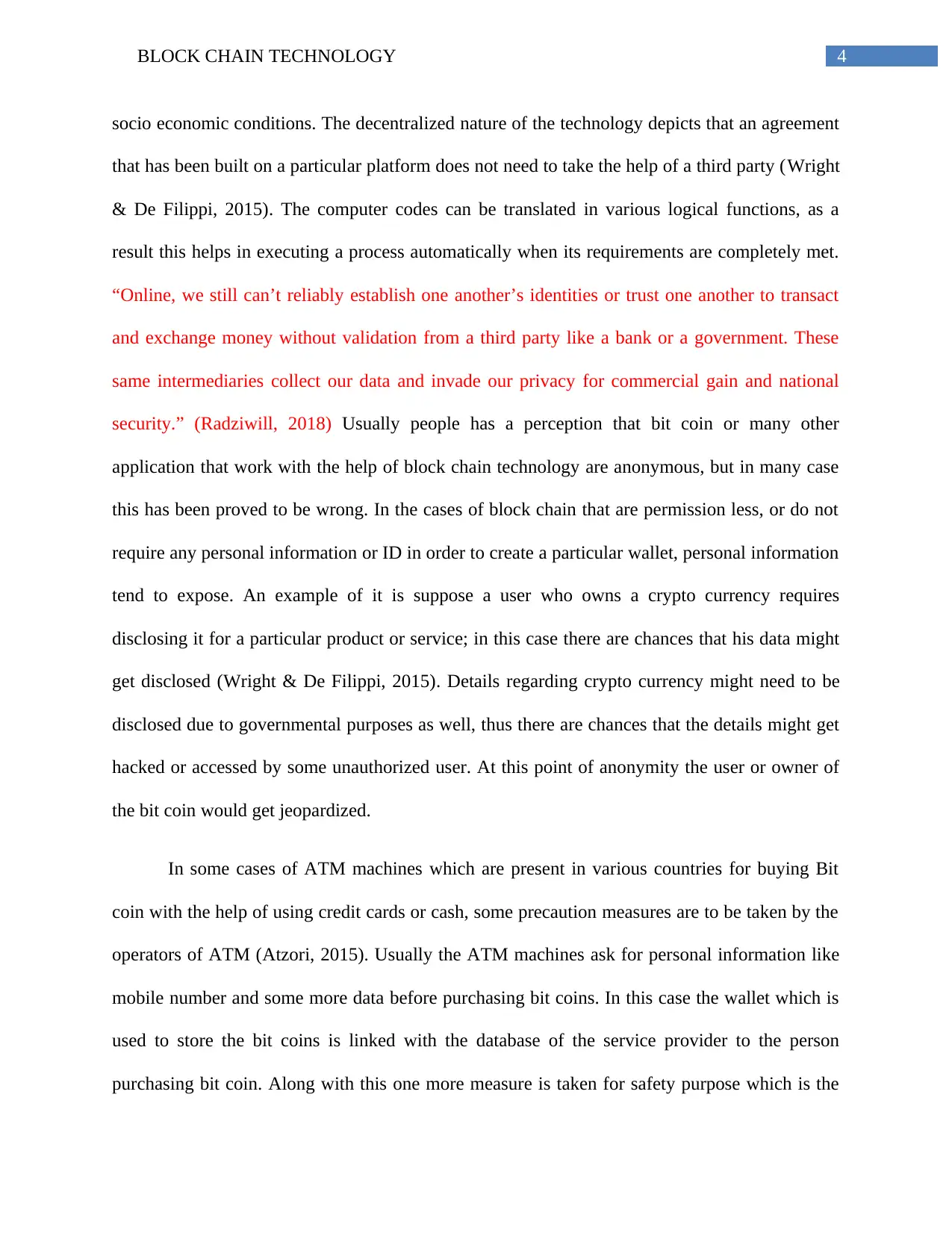
4BLOCK CHAIN TECHNOLOGY
socio economic conditions. The decentralized nature of the technology depicts that an agreement
that has been built on a particular platform does not need to take the help of a third party (Wright
& De Filippi, 2015). The computer codes can be translated in various logical functions, as a
result this helps in executing a process automatically when its requirements are completely met.
“Online, we still can’t reliably establish one another’s identities or trust one another to transact
and exchange money without validation from a third party like a bank or a government. These
same intermediaries collect our data and invade our privacy for commercial gain and national
security.” (Radziwill, 2018) Usually people has a perception that bit coin or many other
application that work with the help of block chain technology are anonymous, but in many case
this has been proved to be wrong. In the cases of block chain that are permission less, or do not
require any personal information or ID in order to create a particular wallet, personal information
tend to expose. An example of it is suppose a user who owns a crypto currency requires
disclosing it for a particular product or service; in this case there are chances that his data might
get disclosed (Wright & De Filippi, 2015). Details regarding crypto currency might need to be
disclosed due to governmental purposes as well, thus there are chances that the details might get
hacked or accessed by some unauthorized user. At this point of anonymity the user or owner of
the bit coin would get jeopardized.
In some cases of ATM machines which are present in various countries for buying Bit
coin with the help of using credit cards or cash, some precaution measures are to be taken by the
operators of ATM (Atzori, 2015). Usually the ATM machines ask for personal information like
mobile number and some more data before purchasing bit coins. In this case the wallet which is
used to store the bit coins is linked with the database of the service provider to the person
purchasing bit coin. Along with this one more measure is taken for safety purpose which is the
socio economic conditions. The decentralized nature of the technology depicts that an agreement
that has been built on a particular platform does not need to take the help of a third party (Wright
& De Filippi, 2015). The computer codes can be translated in various logical functions, as a
result this helps in executing a process automatically when its requirements are completely met.
“Online, we still can’t reliably establish one another’s identities or trust one another to transact
and exchange money without validation from a third party like a bank or a government. These
same intermediaries collect our data and invade our privacy for commercial gain and national
security.” (Radziwill, 2018) Usually people has a perception that bit coin or many other
application that work with the help of block chain technology are anonymous, but in many case
this has been proved to be wrong. In the cases of block chain that are permission less, or do not
require any personal information or ID in order to create a particular wallet, personal information
tend to expose. An example of it is suppose a user who owns a crypto currency requires
disclosing it for a particular product or service; in this case there are chances that his data might
get disclosed (Wright & De Filippi, 2015). Details regarding crypto currency might need to be
disclosed due to governmental purposes as well, thus there are chances that the details might get
hacked or accessed by some unauthorized user. At this point of anonymity the user or owner of
the bit coin would get jeopardized.
In some cases of ATM machines which are present in various countries for buying Bit
coin with the help of using credit cards or cash, some precaution measures are to be taken by the
operators of ATM (Atzori, 2015). Usually the ATM machines ask for personal information like
mobile number and some more data before purchasing bit coins. In this case the wallet which is
used to store the bit coins is linked with the database of the service provider to the person
purchasing bit coin. Along with this one more measure is taken for safety purpose which is the
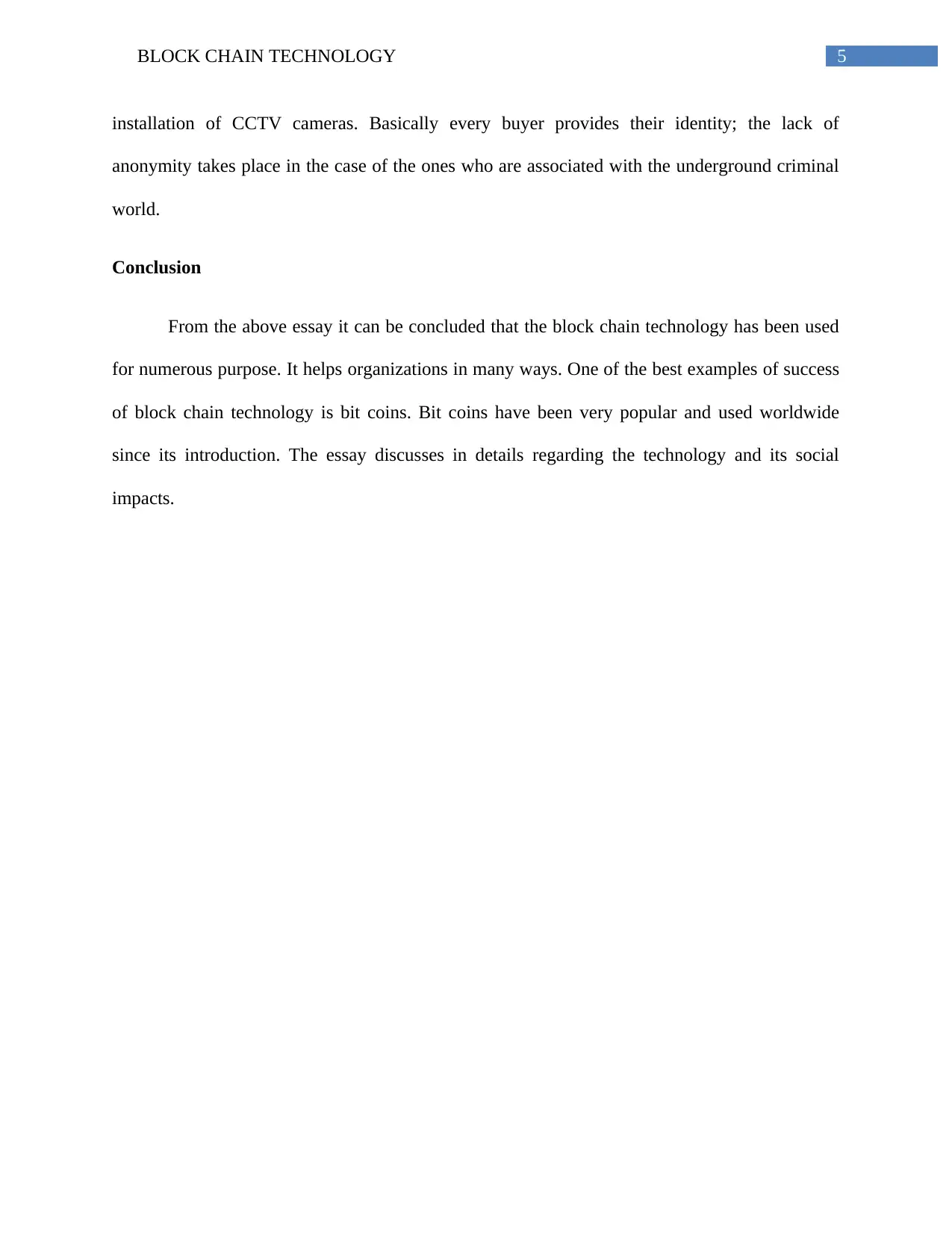
5BLOCK CHAIN TECHNOLOGY
installation of CCTV cameras. Basically every buyer provides their identity; the lack of
anonymity takes place in the case of the ones who are associated with the underground criminal
world.
Conclusion
From the above essay it can be concluded that the block chain technology has been used
for numerous purpose. It helps organizations in many ways. One of the best examples of success
of block chain technology is bit coins. Bit coins have been very popular and used worldwide
since its introduction. The essay discusses in details regarding the technology and its social
impacts.
installation of CCTV cameras. Basically every buyer provides their identity; the lack of
anonymity takes place in the case of the ones who are associated with the underground criminal
world.
Conclusion
From the above essay it can be concluded that the block chain technology has been used
for numerous purpose. It helps organizations in many ways. One of the best examples of success
of block chain technology is bit coins. Bit coins have been very popular and used worldwide
since its introduction. The essay discusses in details regarding the technology and its social
impacts.

6BLOCK CHAIN TECHNOLOGY
References
Atzori, M. (2015). Blockchain technology and decentralized governance: Is the state still
necessary?.
Buchanan, B., & Naqvi, N. (2018). Building the Future of EU: Moving forward with
International Collaboration on Blockchain. The JBBA, 1(1), 3579.
Cohen, L. R., Samuelson, L., & Katz, H. (2017). How Securitization Can Benefit from
Blockchain Technology. The Journal of Structured Finance, 23(2), 51-54.
Iansiti, M., & Lakhani, K. R. (2017). The truth about blockchain. Harvard Business
Review, 95(1), 118-127.
Jain, A., Jain, A., Chauhan, N., Singh, V., & Thakur, N. (2018). Seguro Digital storage of
documents using Blockchain.
Lemieux, V. L. (2016). Trusting records: is Blockchain technology the answer?. Records
Management Journal, 26(2), 110-139.
Mougayar, W. (2016). The business blockchain: promise, practice, and application of the next
Internet technology. John Wiley & Sons.
Pilkington, M., & Lee, J. H. (2017). How the Blockchain Revolution Will Reshape the Consumer
Electronics Industry.
Radziwill, N. (2018). Blockchain Revolution: How the Technology Behind Bitcoin is Changing
Money, Business, and the World. 2016. Dan Tapscott and Alex Tapscott. New York:
Penguin Random House. 348 pages.
References
Atzori, M. (2015). Blockchain technology and decentralized governance: Is the state still
necessary?.
Buchanan, B., & Naqvi, N. (2018). Building the Future of EU: Moving forward with
International Collaboration on Blockchain. The JBBA, 1(1), 3579.
Cohen, L. R., Samuelson, L., & Katz, H. (2017). How Securitization Can Benefit from
Blockchain Technology. The Journal of Structured Finance, 23(2), 51-54.
Iansiti, M., & Lakhani, K. R. (2017). The truth about blockchain. Harvard Business
Review, 95(1), 118-127.
Jain, A., Jain, A., Chauhan, N., Singh, V., & Thakur, N. (2018). Seguro Digital storage of
documents using Blockchain.
Lemieux, V. L. (2016). Trusting records: is Blockchain technology the answer?. Records
Management Journal, 26(2), 110-139.
Mougayar, W. (2016). The business blockchain: promise, practice, and application of the next
Internet technology. John Wiley & Sons.
Pilkington, M., & Lee, J. H. (2017). How the Blockchain Revolution Will Reshape the Consumer
Electronics Industry.
Radziwill, N. (2018). Blockchain Revolution: How the Technology Behind Bitcoin is Changing
Money, Business, and the World. 2016. Dan Tapscott and Alex Tapscott. New York:
Penguin Random House. 348 pages.
Paraphrase This Document
Need a fresh take? Get an instant paraphrase of this document with our AI Paraphraser
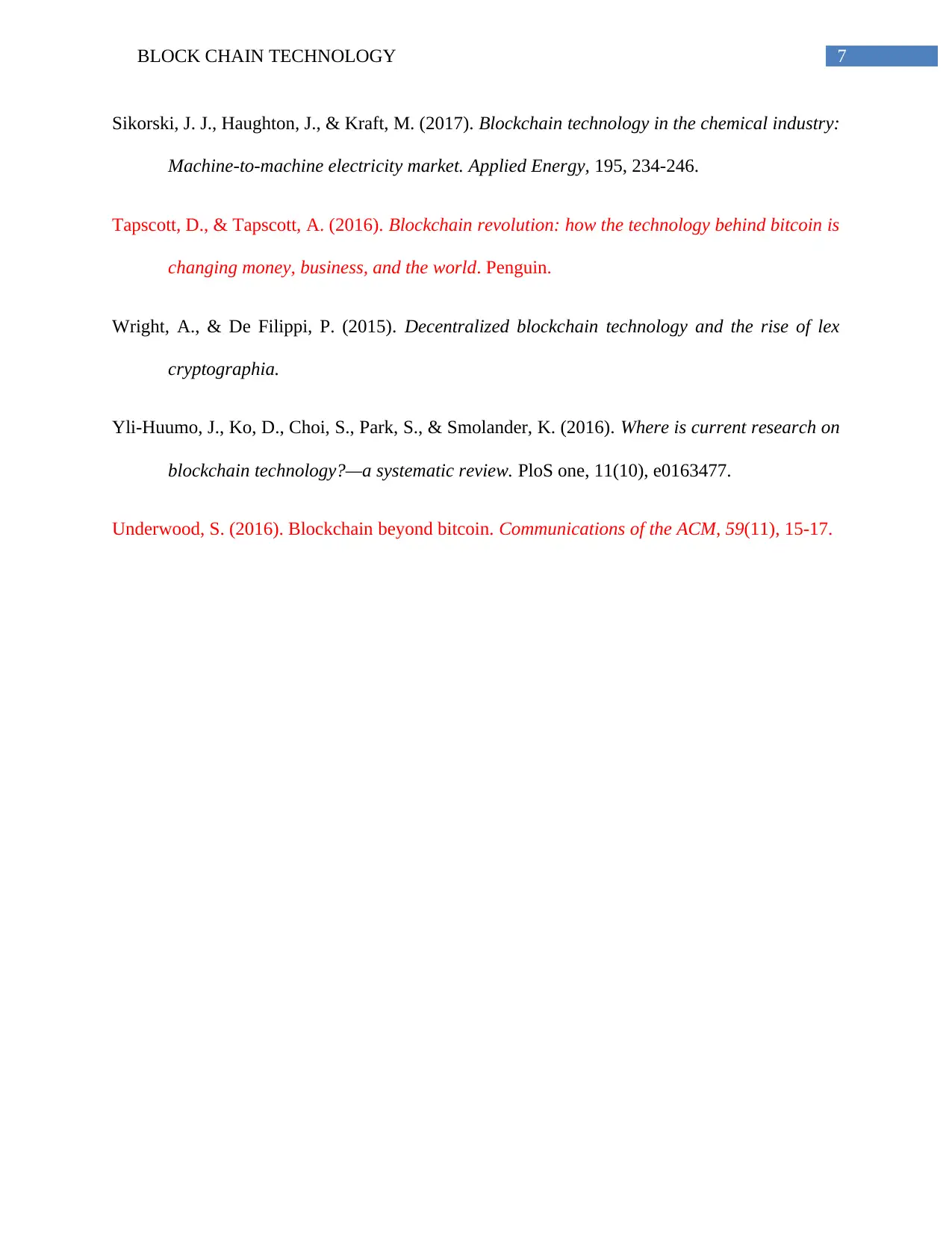
7BLOCK CHAIN TECHNOLOGY
Sikorski, J. J., Haughton, J., & Kraft, M. (2017). Blockchain technology in the chemical industry:
Machine-to-machine electricity market. Applied Energy, 195, 234-246.
Tapscott, D., & Tapscott, A. (2016). Blockchain revolution: how the technology behind bitcoin is
changing money, business, and the world. Penguin.
Wright, A., & De Filippi, P. (2015). Decentralized blockchain technology and the rise of lex
cryptographia.
Yli-Huumo, J., Ko, D., Choi, S., Park, S., & Smolander, K. (2016). Where is current research on
blockchain technology?—a systematic review. PloS one, 11(10), e0163477.
Underwood, S. (2016). Blockchain beyond bitcoin. Communications of the ACM, 59(11), 15-17.
Sikorski, J. J., Haughton, J., & Kraft, M. (2017). Blockchain technology in the chemical industry:
Machine-to-machine electricity market. Applied Energy, 195, 234-246.
Tapscott, D., & Tapscott, A. (2016). Blockchain revolution: how the technology behind bitcoin is
changing money, business, and the world. Penguin.
Wright, A., & De Filippi, P. (2015). Decentralized blockchain technology and the rise of lex
cryptographia.
Yli-Huumo, J., Ko, D., Choi, S., Park, S., & Smolander, K. (2016). Where is current research on
blockchain technology?—a systematic review. PloS one, 11(10), e0163477.
Underwood, S. (2016). Blockchain beyond bitcoin. Communications of the ACM, 59(11), 15-17.
1 out of 8
Related Documents
Your All-in-One AI-Powered Toolkit for Academic Success.
+13062052269
info@desklib.com
Available 24*7 on WhatsApp / Email
![[object Object]](/_next/static/media/star-bottom.7253800d.svg)
Unlock your academic potential
© 2024 | Zucol Services PVT LTD | All rights reserved.





